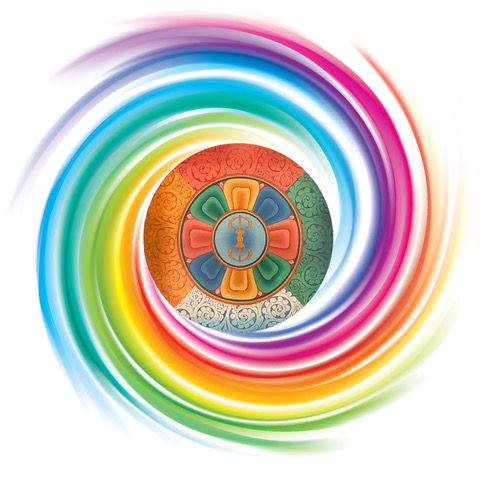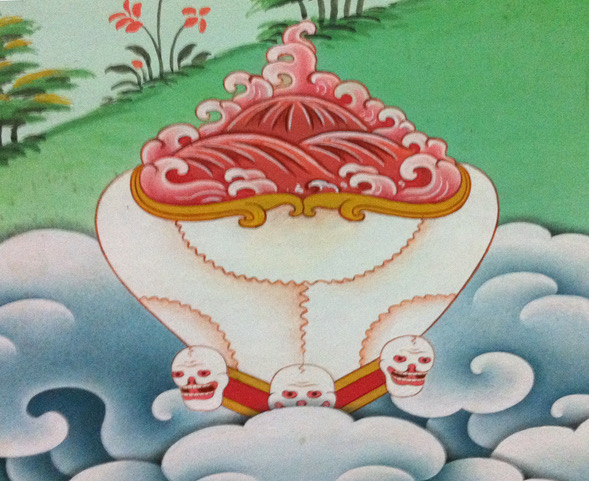FEATURES|COLUMNS|The Five Wisdoms
Science and the Rainbow Body, Part 6: Five Elements High and Low
We have looked at some aspects of what modern biophysics, biophotonics, phonics (sound), and neurology can bring to our understanding of the Light Body. And the anatomical discovery of the microscopic primo vascular system and fascial tissue give us new perspectives on tsas, nadis, meridians, and the body’s energy channels in general. But at some point science is left in the dust. It cannot keep up with ancient esoteric knowledge, cooked for millennia in the crucible of direct inner experience, not intellectual theories. This particularly refers to the science of the Five Elements, and the loss and distortion of this knowledge in Western intellectual culture, medicine, and religion.
That massive misstep began long ago. While ancient Greece is taken to be the fount of our Western scientific tradition, it is also where materialism took hold fiercely, relegating scientists to the study of physical objects, functions, and ever smaller components. It’s only now, thousands of years later, that physics—and a good dose of Eastern spirituality—promise a revived view of a living, conscious universe. In nature, and in the realm of biology, it is grids of information-energy that rule supreme. Aristotle, Hippocrates, and Galen could not abide the idea of five intangible formative forces and downgraded the elements into gloppy fluids sloshing about in the spaces of the body. To be fair, this was in response to the Egyptian and Babylonian perspective, held for thousands of years, of the elements as deities. Empedocles famously called these deities “roots,” turning them into a proprietary system and establishing his place in history. But the notion of a space element, already an integral part of Pythagorean knowledge adopted from Egypt and Babylon a century before, was out in the cold. This left us with the fantasy of hydraulic fluids running the body (the humoral theory), which would pervade European and Middle Eastern thought right into the modern era—tainting astrology, alchemy, and reflected in the truncated four-part psychology of Jung, Keirsey, and Myers-Briggs. But while this artifact of materialistic thinking affected a hundred generations of beings, the true knowledge of elemental forces has remained intact, preserved in Tibetan Buddhism, Indian Shaivism, Sufic healing, and the Western gnostic lineages. That is a good thing, since they play a central role in the development of the Rainbow or Light Body. That is as it should be, since it is not myth that we are composed, mind and body, of five dynamic patterns of meaning and manifestation.

Image courtesy of the author
Elements, elements everywhere
In the process of creation, of manifestation, the higher is separated from the lower: gravity and levity, roots and fruits, sky and earth. Now, we reverse the process, climbing back toward union. But a simple reversion to the primordial state, to a pure unity of warm consciousness incomprehensible to our dull intellect would miss the point. Our journey as an embodied five-elemental being is not just a movement within an illusion of time and space where “nothing actually happens.” The return is everything, and in many ways the fulfillment of creation itself. It is the ouroboros, the snake that devours its own tail, the completion of the circle, which is itself empty and contains everything.
This elemental transformation process is commonly portrayed in Tibetan thangkas and repeated in almost every ritual. Within a human skull cup we visualize five kinds of meat (forbidden foods, according to Brahmanical literature) and five kinds of bodily fluids. Their specific names are not important for this discussion, but they represent the Five Elements in their female and male aspects. This mishmash is the sum of our physical existence. Here is biology; here is embodiment; here is incarnation—being in the flesh. But here is the possibility of the birth of a new, non-material form as a vehicle for a renewed consciousness. These elements will be cooked and transformed into wisdom nectar, due to the magical addition of Om Ah Hung. In Tibetan, these three syllables represent form, energy, and consciousness, although I prefer G. I. Gurdjieff’s more colorful nomenclature of “Holy Denying, Holy Affirming, and Holy Reconciling.”
Inherent fives
The reason for this transformative possibility in the first place is that the Five Elements exist within us in a multi-layered context. We contain the five material elements, but also the five original, pure Wisdom Elements, the cosmic spark as it were. The Hindu tradition describes five koshas or levels of existence, from gross to subtle, from bioenergetic to pure consciousness. The Buddhist world speaks of three bodies or kaya in a similar spectrum. The Kabbalah describes five worlds in a descending chain of existence. Whether we count in threes, fives, or beyond, the problem remains—how to unite the lower and the higher to create something altogether new. Traditionally, we perceive each of the Vajrayana chakras as the center of gravity of one of the elements—but containing an inner structure of five subelements. And so we have elements within elements waiting to be impregnated with divine radiance and to ascend to their true potential.
Cooking the elements
Down in the depths of our viscera, in the dark recess of the pelvic container, is a secret bindu, an energetic sphere, a “bubble” of immense import. The yogin or yogini will have long prepared, through visualization, mantra recitation, focused meditation, and the gathering of blessings, creative forces, and the richness of material, planetary, biological, and spiritual energies. Prolonged purifications have taken place, readying for this moment. Now, in this most secret of places, the alchemical process, the gestation of a new Light Body begins. Conception took place long ago, in different forms of initiations, meetings with the guru, or even a direct download from transcendent sources. Now the quickening begins, the “cooking” process. As in our visualized skull cup of animals and fluids, we ignite the fire in the belly and fan it with the reversed turbulence of our “downward descending wind.” The digestive and liver fire is harnessed, and winds are drawn down and held in the vase of the belly. The anus and lower doors are drawn up and sealed. As the sub-navel furnace blazes, the Earth mandala in the belly dissolves and is drawn upward by a natural osmosis, the force of levity, of ionic attraction, in the oldest dance in the universe.

Image courtesy of the author
Spiral dynamics
In this “mating” process, the flame rises up to melt the Wisdom Elements dwelling in the head. This inner heat or tummo process involves spiral energies. The heavenly father energies move clockwise, always. The earthly mother energies move in an anti-clockwise spiral, always. This is clearly seen in the way that a mantra circles within the heart, depending on whether one is self-visualized as a male or female yidam or deity form. The male mantra circles to the right and the female mantra always circles to the left (from the perspective of your own body’s orientation). Spiraling down, the flow moves through the chakras producing the “four joys.” But it spirally ascends to the head again, thrusting through the chakras with another more intense effulgence of innate bliss and the experience of pure awareness (or emptiness, as it is misleadingly called).
By this process, each element in its lower or biological state is transformed, united with and blended with its wisdom form. But what is very surprising here is that, in the Vajrayana tradition, the story somehow ends. We rest in this new state of unfabricated being-knowing, merging it with various aspects of mundane existence, including arising thoughts and feelings and experiences. All is painted with a new brush. The “doors of perception” are cleansed in a utopian brave new world of consciousness.
Beginning, not ending
But the journey is far from over. What has been described above in traditional terms involves a massive movement within the water-based electron grid of cells and interstitial tissue. It is a volcanic eruption and lava flow of the packets of massed biophotons from the cerebrospinal fluid and brain’s ventricles. We have every reason to understand that photons are the vehicles of consciousness—or that consciousness is an intrinsic quality of photons. And we have clear indications that the structured water in cells, tissues, and blood is the electron-source of prana or lūng itself. As a result of this co-mingling of side-to-side, front-to-back, and finally top-and-bottom, the Light Body begins to form in earnest. Each of the elemental chakras is now part of the Rainbow anatomy containing a mandala of subelements brimming with pristine Wisdom Element force. Channels, energy, and consciousness—tsa, lūng, and tiglé—are all benefactors of the primary template of all things: the Five Elements known as Earth, Water, Fire, Air, and Space.
In part seven, we will look more closely at the nature of prana, as well as the strangely overlooked reason why Vajrayana has two systems of chakras.
See more
Related features from Buddhistdoor Global
Science and the Rainbow Body, Part 5: Coming Together
Maithuna: Reflections on the Sacred Tantric Union of Masculine and Feminine
Demystifying the Yoga of Bliss: An Interview with Dr. Nida Chenagtsang, Part One
Sexuality in the Tibetan Buddhist Tradition: An Interview with Dr. Nida Chenagtsang, Part Two














